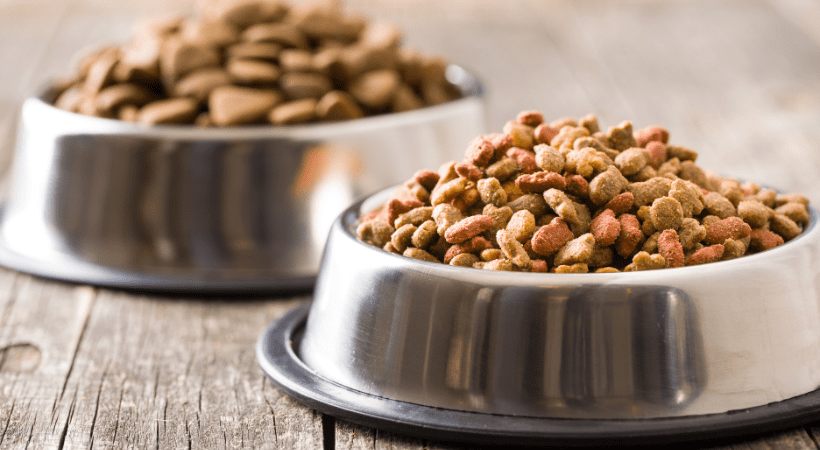Beyond the Label: Understanding Pet Food Jargon
Beyond the Label: Understanding Pet Food Jargon
Our pets are valued members of the family, with research suggesting that over two-thirds of us are willing to spend more on our pets than we do on ourselves, whether that’s on luxury beds, toys, treats or food.
But while consumers are eager to spend more on their pets, millions of pet owners have no idea what they’re actually feeding their pets.

Reading the label is one thing, but understanding the jargon and cutting through the noise is a different challenge entirely. Packed with a myriad of unclear ingredients such as ‘gums’, ‘additives’ and ‘derivatives’ of a mystery nature, it’s difficult for pet owners to discern what’s best for their pets. Add to this labelling jargon such as ‘complete food’ or ‘all natural ingredients’, and consumers can be easily confused as to what exactly they’re putting in their pet’s food bowl.
Here at Ashbury, we’ve taken a look at what some commonly confused pet food label elements mean and how pet owners make better decisions for their pets.
Cutting through Pet Food Jargon
‘Complete’ Food
A ‘complete’ food for pets is a ‘compound feed which, because of its composition, is sufficient for a daily ration.’ That might not make much sense at first glance, but what this really means is that the food is made up of ingredients and has been specifically formulated to contain all the essential nutrients your pet needs for a balanced diet.
This is important because it allows consumers to understand instantly that the food they’re purchasing for their pets is going to be enough to keep them well looked after, as long as the right portion sizes are used.
‘Rich in’ and ‘flavoured with’ labels
Pet food labels with terms such as ‘rich in’, ‘with real’ or flavoured with’ on them can pose difficult questions for consumers. If my pet’s food is ‘flavoured with chicken’ what does this mean in terms of nutritional value and composition?
These terms are called ‘component claims’, and each can mean something different. For example:
- Flavoured with Chicken – must contain more than 0% chicken, but less than 4%
- With Chicken / Contains Chicken – must contain at least 4% chicken
- Rich in Chicken / High in Chicken / With Extra Chicken – must contain at least 14% chicken
- Chicken / Chicken Menu / Chicken Dinner – must contain at least 26% chicken
In foods labelled as All Chicken / Only Chicken, the only feed material present must be chicken, although added nutrients and minerals are allowed too.
Is ‘wheat-free’ pet food actually wheat-free?
When it comes to whether a food is ‘free from’ a certain ingredient or attribute, the European Pet Food Industry Federation (FEDIAF) have a useful definition.
The definition FEDIAF gives is that “if a food is free from something it implies that there are not even traces present”, and it goes on to say that “negative claims or absence claims should not directly, indirectly or implicitly be used if: a. all similar goods in the same category or class or all pet food do not contain the substance in question or b. give the impression that products containing that particular substance/feature are dangerous.
Consumers might not notice that ‘free-from’ claims are used when a ‘no-added’ claim might have been a better descriptor. The ‘no-added’ label accounts for the fact there may be small traces of material present in the finished food because the same production line has also been used to make food containing that ingredient; ‘wheat’ for example.
This is called cross-contamination. Some products with the claim ‘wheat-free’ have a statement saying that they are manufactured on a site which handles wheat for example.
It’s useful for pet owners to have some guidance as to what the recipe does not contain, if, for instance, their pet is on a diet excluding particular ingredients like wheat because of suspected or confirmed intolerances.
What are ‘natural ingredients?’ What does that mean?
For a product to be able to claim it uses ‘natural ingredients’, it has to meet certain criteria. Most pet food manufacturers in the UK would follow the FEDIAF definition for ‘Natural’ which should only be used to describe ‘substances to which nothing has been added, and which have been subjected to such physical processing as to make them suitable for pet food production and maintaining the natural composition’.
Pet food can claim to use natural ingredients if it has been through some other processes, however, such as freezing, drying, concentration, smoking (without chemicals) and pasteurisation.
You’ll often find natural ingredients marked on the label with an asterisk symbol, where the symbol is used to indicate that the ingredient is natural. For example, a label could look like this:
Composition: chicken*, carrots*, pea extract… etc
*Natural – This shows that the chicken and carrots comply with the official definition of natural.

How can pet owners ensure they’re buying the right food for their pets?
Demelza Sully, Regulatory Advisor at Ashbury said, “As a nation of pet lovers, we’re always looking to spoil our pets. While that is often with toys or treats, it can be easy to overlook what we’re relying on to keep our pets well-fed and healthy.
It’s really important that consumers carefully read the label on their pets’ food and understand what the listed ingredients are, and are not.
We’ve seen an emergence of new competitors looking to disrupt the pet food market in recent years, and it’s important that those new manufacturers know how to navigate the various laws and regulations governing what can and can’t go on a pet food label. We recommend using a label checking service to ensure everything is compliant and above board.
For consumers who want to be sure they’re feeding their pets the right foods for them, it’s always best to speak to a qualified veterinarian.”

Author: Rebecca Kaya
I have dedicated over 17 years' of my career to keeping end consumers safe. As a Regulatory Specialist, I help clients to have confidence in their compliance by providing practical advice across the food chain - from the point of primary production, to final product labelling.
Next reads
What’s Next for Food & Drink? Our Experts’ Predictions for 2026
The Peanut Diaries: School and Social Occasions
The Peanut Diaries: Navigating Social Events and Celebrations with Food Allergies
The Peanut Diaries: A Parent’s Journey to Uncovering their Child’s Allergy
Keep up to date with our latest insights
Subscribe to our mailing list to stay in touch with the latest news, insights and updates from Ashbury




